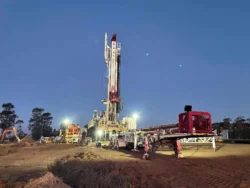Understanding How Different Ground Types Affect Borehole Drilling

When it comes to drilling a borehole, the type of ground beneath the surface plays a critical role in determining the approach, equipment, and overall success of the project. Whether you’re drilling through rock, soil, or clay, each ground type presents unique challenges and requires specific techniques to ensure the borehole is both effective and sustainable. In this blog, we’ll explore how different ground conditions impact the borehole drilling process.
1. Rocky Terrain: Precision and Power
Challenges: Drilling through solid rock is one of the most demanding tasks in borehole drilling. Rock formations, especially hard rock types like granite, basalt, and quartzite, are incredibly dense and resistant to penetration. These conditions require specialised equipment and techniques to break through without causing damage to the drilling tools or compromising the integrity of the borehole.
Drilling Techniques:
- Rotary Drilling: Rotary drilling is often used in rocky terrain. It involves a rotating drill bit that grinds through the rock. The bit is typically made of hard materials such as tungsten carbide or diamond to withstand the abrasive nature of the rock.
- Percussion Drilling: In some cases, percussion drilling may be employed, where a hammering action is combined with rotation to pulverise the rock. This method is particularly effective in breaking through harder rock layers.
- Mud Drilling: Drilling fluid, often referred to as “mud,” is used to cool the drill bit, carry rock cuttings to the surface, and stabilise the borehole walls. This is crucial in rocky environments where the risk of borehole collapse is higher.
Considerations: Drilling through rock is typically slower and more expensive due to the wear and tear on equipment and the need for more powerful machinery. However, the stability provided by rock formations can result in a long-lasting and durable borehole.
2. Soil: Balance and Stability
Challenges: Soil is generally easier to drill through than rock, but it comes with its own set of challenges. The primary concern when drilling in soil is maintaining the stability of the borehole walls, as loose soil can collapse into the hole. Soil types can vary significantly, from loose sandy soils to more cohesive clay-rich soils, each requiring a tailored approach.
Drilling Techniques:
- Auger Drilling: Auger drilling is commonly used in soil conditions, where a rotating helical screw (auger) is used to bring the soil cuttings to the surface. This method is effective in softer soils and allows for quick drilling.
- Casing: To prevent borehole collapse in loose soils, temporary casing is often installed as the drilling progresses. The casing provides support to the borehole walls and prevents loose soil from falling in.
- Air Rotary Drilling: In drier, sandy soils, air rotary drilling may be employed. Compressed air is used to lift the cuttings out of the borehole, which can be more effective in these conditions than using drilling mud.
Considerations: Drilling in soil is generally faster and less costly than in rock. However, ensuring borehole stability is crucial, especially in loose or unconsolidated soils. Proper casing and the use of drilling fluids can help mitigate the risks associated with soil drilling.
3. Clay: Managing Stickiness and Swelling
Challenges: Clay presents unique challenges due to its sticky and plastic nature. It tends to adhere to drilling equipment, causing clogging and slowing down the drilling process. Additionally, clay can swell when exposed to water, leading to borehole instability.
Drilling Techniques:
- Mud Rotary Drilling: In clay-rich environments, mud rotary drilling is often the preferred method. The drilling fluid helps to lubricate the drill bit, reduce the stickiness of the clay, and stabilize the borehole walls.
- Polymer-Based Fluids: In some cases, polymer-based drilling fluids may be used instead of traditional mud. These polymers help to control the swelling of the clay and improve borehole stability.
- Reaming: Reaming the borehole—enlarging it slightly—can help reduce the risk of clay swelling and ensure that the borehole remains open.
Considerations: Clay can be particularly troublesome during drilling due to its tendency to swell and cause blockages. Managing the water content in the drilling fluid and choosing the right additives can make a significant difference in the success of drilling in clay-rich areas.
Conclusion: The Ground Dictates the Approach
The ground beneath your feet plays a pivotal role in determining the method, equipment, and overall approach to borehole drilling. Whether you’re dealing with hard rock, loose soil, or sticky clay, understanding the characteristics of the ground is essential for ensuring a successful drilling operation. At FB Drilling, our team of experts is equipped with the knowledge and technology to handle a wide range of ground conditions, ensuring that your borehole is drilled efficiently and effectively, no matter the challenges.
If you’re considering drilling a borehole for your commercial or industrial needs, trust FB Drilling to provide the expertise and customized solutions you need to achieve the best results.
Contact Us
